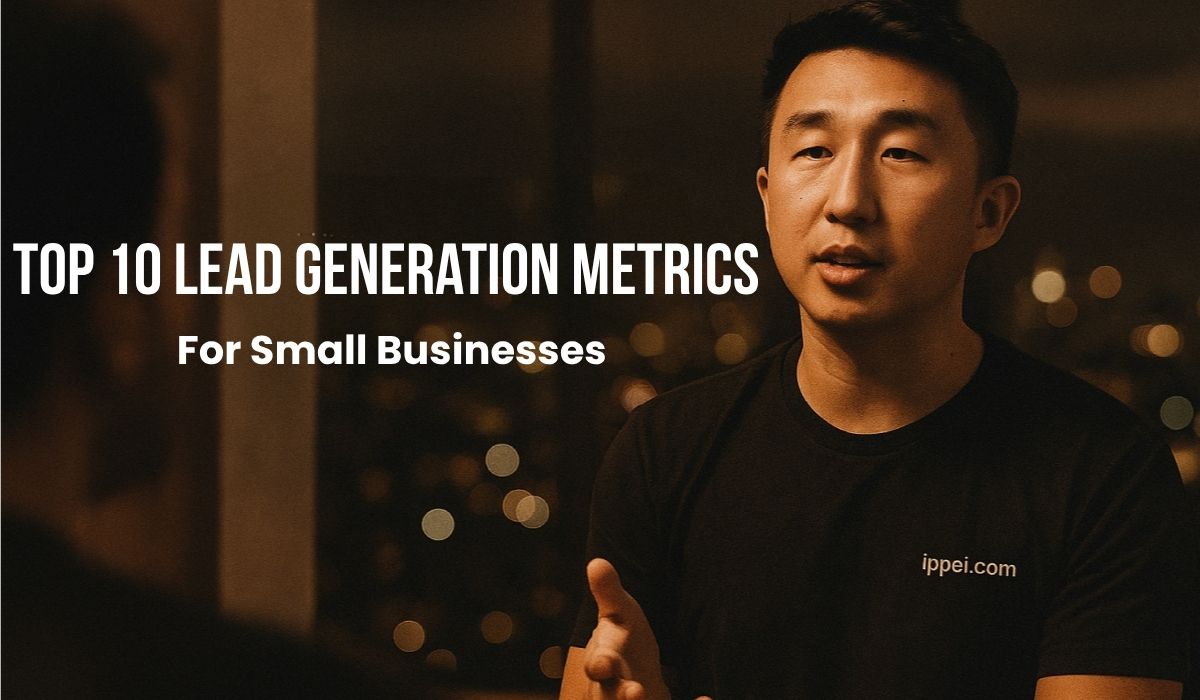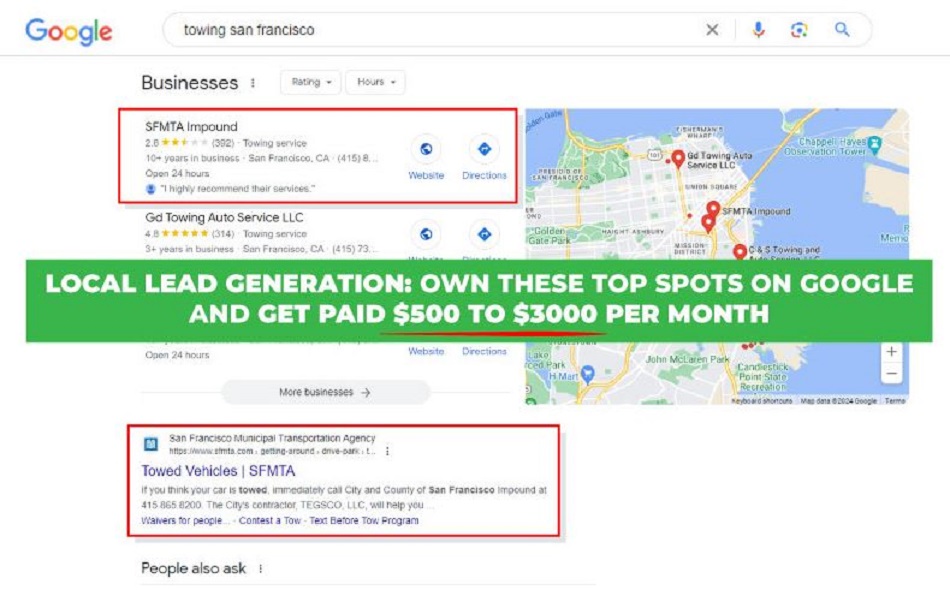Top 10 Lead Generation Metrics For Small Businesses | ROI, CVR, & CPL

The top lead generation metrics for small businesses are:
- Return on investment
- Conversion rate
- Cost per lead
- Lead quality
- Number of leads
- Customer acquisition cost
- Sales cycle length
- Lead response time
- Lead churn
- Leads per channel
A lead generation metric is a quantifiable measurement used to evaluate the effectiveness of marketing and sales efforts. These numerical figures highlight the ability to attract, nurture, and convert potential customers.
You measure the success of lead generation by setting key performance indicators (KPIs) and tracking business data. Lead gen KPIs provide clear numerical figures that allow a business to assess performance by comparing intended results to actual results. You set KPIs for lead generation by:
- Defining your business goals
- Identifying relevant lead generation metrics to track
- Setting lead generation benchmarks to meet
- Monitoring and adjusting KPIs based on business needs
There are many strategies and tools for tracking lead generation performance metrics. For example, a Google Ads agency owner on Reddit notes that they have almost everything they need to effectively track lead generation data through the Google Ads dashboard.
I’ve been generating leads for small businesses for over a decade using SEO. Monitoring lead generation metrics like cost per lead and number of leads has been crucial in achieving profitability with my business. In the following article, I’ll discuss the most important lead generation metrics and discuss the best ways to track them.
1. Return on investment (ROI)
Measures the amount of revenue generated from leads acquired through marketing efforts relative to the money spent on generating those leads.
Lead generation ROI = (revenue from lead generation - lead generation spend)/lead generation spend x 100
ROI is the most important metric for lead generation because it directly shows you if the money spent on lead generation is worth the investment. ROI can reveal whether you are profitable with different lead generation tactics and which of those tactics are providing the greatest impact on the business.
An ROI of 5:1, $5 generated for every $1 spent, is considered good for a digital marketing campaign, according to Oracle. A ratio of 10:1 is considered excellent and anything below 2:1 is considered poor performance.
2. Conversion rate (CVR)
Percentage of users that take a desired action. It’s measured as the percentage of leads that convert into customers in the context of lead generation. It’s also used to measure the effectiveness of different stages of a marketing funnel. Such as what percent of website visitors book a call and then what percent of those customers that attend the call purchase the product or service.
Conversion rate = (number of users who convert/total audience size) x 100
Conversion rate is one of the most important lead generation metrics for small businesses because it directly measures the success rate of the marketing campaign. It shows you which marketing strategies, funnels, and landing pages are generating the most benefit for the business.
A good conversion rate is generally considered to range between 2% - 5%. However, this depends on factors like specific product, industry, and what’s actually being measured. For example, Shopify claims that a 10% conversion rate is good for Ecommerce products.
3. Cost per lead (CPL)
Measures how much money it costs to acquire a lead. The amount of resources a business spends on average across all marketing channels to get new business opportunities.
Cost per lead = total lead generation expenses/total number of unique leads
Cost per lead is a useful metric to consider with other business metrics. Most notably, conversion rate and the average cost of the product or service. For example, say a roofing company charges an average of $10,000 per job. If they pay $200 per lead and those leads have a conversion rate of 5%, the business spends around $4,000 to acquire a $10,000 job. This information is highly useful in gauging project profitability when analyzing business opportunities.
Home services like roofing, plumbing, and HVAC have cost per leads ranging between $30 - $200, according to Angie’s List and Home Advisor. A report by Hubspot outlines the CPL for SaaS companies as ranging between $50 - $250.
4. Lead quality
How well a lead matches a business’s ideal target customer profile. The best leads have:
- A need for the product or service offered
- Shown interest in purchasing the product or service
- Already experienced multiple touchpoints and are ready to take the next step
Lead quality is not measured with a simple calculation. Instead, leads can be graded for quality by creating a lead scoring system. You choose a scale, such as 1- 10. Then, go through each category and score the lead. Leads with the highest number of points have the greatest lead quality. Many businesses use the BANT system to score leads. BANT stands for:
- Budget - Does the lead have the fund to purchase the offer?
- Authority - Is the lead the decision maker in the household?
- Need - Does the lead have a good reason to purchase the offer?
- Timeframe - How soon is the lead ready to buy the offer?
Lead quality helps a business understand which leads they should spend more effort pursuing. It enables a business to avoid wasting resources on low-quality leads and instead focus on high-quality leads that have the greatest chance at conversion.
5. Number of leads
The quantity of leads generated in a specific period.
Number of leads = total count of individuals or entities expressing interest in the offer
Number of leads shows the effectiveness of a marketing campaign by reflecting the number of potential business opportunities produced.
Organizations generate approximately 1,877 leads per month on average, according to SalesHandy. Of course, small businesses can be successful generating substantially fewer leads while major corporations likely need a higher number of leads to be profitable.
6. Customer acquisition cost (CAC)
Measures how much money a business spends to acquire a new customer. A numerical figure that represents the marketing expense of a single new business opportunity.
Customer acquisition cost = total lead generation expenses/number of new customers acquired
CAC helps a business understand how efficiently they are converting leads into paying customers relative to the amount of money spent on lead generation activities. A high customer acquisition cost indicates a business may need to change strategy to achieve profitability. A business that spends more on acquiring customers than the customer spends with the business is losing money.
Ecommerce platform Shopify notes that an acceptable CAC varies by industry. For example, arts and entertainment has an average CAC of $21 while electronic product CAC averages upwards of $377.
7. Sales cycle length
The time it takes for a prospect to go from a lead to a paying customer. Span of time between the first interaction with the potential customer and the closing of the sale.
Sales cycle length = total number of day from first contact to close all deals/total number of deals closed
Sales cycle length directly affects lead generation tactics. It affects factors like the type of leads to target, the ways leads are nurtured, and lead conversion strategy. Leads for a business with a shorter sales cycle length are likely to make purchasing decisions more easily. Longer sales cycle lengths indicate the prospect needs extra care and a business should expect to leverage multiple touchpoints to convert leads.
B2C sales cycle lengths tend to be shorter. B2C sales cycles usually end on the day they start, according to Zendesk. On the other hand, B2B sales cycle lengths are generally much longer. The median for B2B sales cycles is around 2.1 months, according to Databox.
8. Lead response time
The amount of time it takes for a business to follow up when a new prospect enters the sales funnel.
Lead response time = time of customer first request - time of first response by business
Lead response time directly impacts conversion rates. The longer a business takes to respond to a lead, the less likely the potential customer is to buy the product or service. In fact, each 10 minute delay in contacting a lead can decrease conversions up to 400%, according to LeadAngel.
It’s optimal to respond to a lead within the first 5 minutes, if possible. That’s because you’re 21x more likely to convert a lead if you contact them within the first 5 minutes rather than 30 minutes or longer, according to Ample Market.
9. Lead churn
Measures the leads that are lost during the sales process. The prospects that enter the sales funnel but don’t make it through to conversion. These are the leads that express interest initially but disengage or are no longer response to further communications.
Lead churn = (number of leads lost/total number of leads at the start of the period) x 100
Lead churn rate can reveal inefficiencies in the marketing funnel. This lead generation metric indicates that the lead generation strategy is producing poor quality leads. A high lead churn rate can also signify that the marketing funnel isn’t properly optimized to guide leads to the point of sale. The lead generation strategy may need to incorporate more customer touchpoints and personalized follow-up to convert more prospects.
Churn rate varies dramatically by industry. The median lead churn rate for energy and utilities is just 11%. On the other end of the spectrum, wholesale experiences a median lead churn rate of 56%, according to Customer Gauge.
10. Leads per channel
Tracks the number of leads generated through each marketing channel over a specific period. For example, separating and counting the leads that come through channels like:
- Organic search (SEO)
- Paid ads (PPC)
- Social media (Facebook, Instagram, TikTok)
Calculating leads per channel is simply counting the number of leads that each marketing channel produces during a timeframe.
Leads per channel helps a business understand where their marketing dollars make the greatest impact. Businesses can use this data to fine tune marketing strategies to make sure the most effective channel gets the majority of the marketing budget.
Good leads per channel varies by industry, company size, and marketing budget. However, let’s look at some typical expectations for PPC ads and SEO. Small to medium sized businesses can generally expect to generate 100 - 1,000 leads from PPC ads like Google Ads and Facebook Ads, according to WordStream. HubSpot notes that ranking for competitive keywords with SEO can generate 100 - 500 leads per month.
How do you track lead generation metrics?
You track lead generation metrics by using a combination of web analytics tools, integrating consumer relationship management systems (CRMs), and leveraging marketing automation softwares.
Web analytics tools allow you to measure website traffic to understand where traffic is coming from and what pages are generating conversions. Google Analytics (GA4) and Google Search Console (GSC) are two of the most popular web analytics tools for tracking lead generation metrics. GA4 allows you to track the entire user journey on your website, including specific events like pageviews, clicks, and downloads. It’s useful for traffic behavior analysis and conversion tracking of both organic and paid sources. GSC provides SEO insights as its primarily focused on website search performance. Google Search Console collects data on what search queries and pages are driving organic website traffic, number of impressions, and indexing status.
![]()
CRMs like Salesforce, Pipedrive, and Zoho CRM allow you to track leads through the sales pipeline. Some of the most common lead generation metrics that CRMs collect and display data on include:
- Number of leads in the sales pipeline
- Conversion rate of leads
- Leads per channel
- Sales cycle length
- Lead churn
Marketing automation softwares like HubSpot, Marketo, and ActiveCampaign simultaneously streamline marketing tasks and record quality data for lead generation tracking. For example, ActiveCampaign is an email marketing automation software that shows you the open rates, click rates, and goal performance of email marketing campaigns. It allows you to build complex email sequences and segment leads as they move through the funnel to better understand lead quality.
What are the top lead generation mistakes?
The top lead generation mistakes include:
- Investing in inefficient marketing channels
- Improper audience targeting
- Skipping qualifying leads
- Ignoring marketing data
- Poor leads nurturing
What are the top lead generation channels?
The top lead generation channels include:
- SEO
- PPC advertising
- Email marketing
- Social media marketing
- Affiliate marketing
Conclusion: What is the best channel for lead generation?
The best channel for lead generation is local SEO. Local SEO boasts high conversion rates and lower competition than other marketing channels. That’s why we teach our students to leverage this channel for generating high-quality leads for businesses.
Local SEO entails ranking on the first page of Google for local service keywords. People typing these queries into Google have high purchase intent. They are looking for a service provider who can fulfill their needs. 76% of potential customers who search for “near me” services visit the business within a day, according to Backlinko. 28% of local searches result in a purchase within 24 hours.
Ranking on Google organically in smaller cities typically takes between 6 weeks to 6 months. That’s much faster than national SEO campaigns, which can take years of investment and effort before a website ranks for keywords that generate good traffic. Furthermore, you typically only need to compete against a handful of small local business owners to rank on Google with local SEO. Other marketing channels like social media can be much more competitive because you compete against national and international brands for traffic.

Learn how to leverage local SEO to produce optimal lead generation KPIs with the local lead generation business model.

Follow Me
Ippei Kanehara
Founder/CEO
$52K per month providing lead generation services to small businesses
Ippei.com is for digital hustlers, industry leaders and online business owners.
His #1 online business recommendation in 2024, is to build your own lead generation business.
